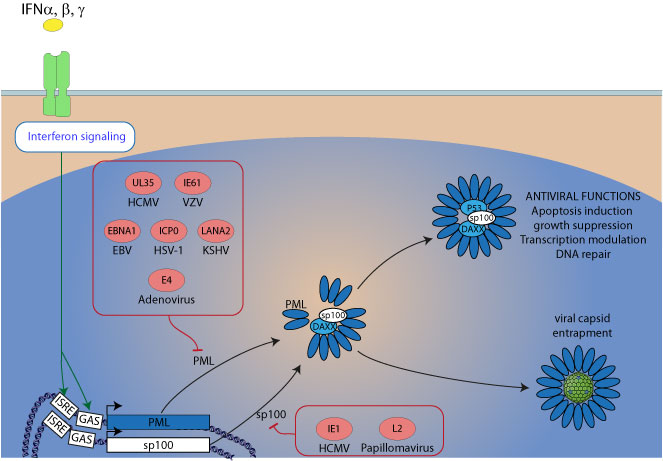PML bodies inhibition

The Promyelocytic Leukemia Protein (PML) is an interferon induced protein of mammalian cells. It forms tiny spheres in the nucleus about 0.1- 1.0 µm in size, called Nuclear bodies (NB) or Nuclear Dots 10 (ND10). NB interact with and concentrate many proteins, chromosomic DNA and viral replication/transcription machinery  . Many nuclear viruses inhibit PML nuclear bodies, thereby preventing the antiviral activity: Herpesviridae, Adenoviridae, Papillomaviridae.
. Many nuclear viruses inhibit PML nuclear bodies, thereby preventing the antiviral activity: Herpesviridae, Adenoviridae, Papillomaviridae.
PML Nuclear Bodies play a role in transcription, suppression of oncogenic transformation, apoptosis promotion, DNA repair, and post-translational modifications (SUMOylation, acetylation, phosphorylation).
Human PML protein comprises seven spliced isoforms (PML-I to PML-VII) involved in the formation of several kinds of nuclear bodies. Overall NB harbor permanent proteins like SP100 and DAXX, plus many transient proteins like p53, CBP etc... They act as post-translational modification hotspot and mediate protein SUMOylation or phosphorylation, and may promote protein degradation during viral infection.
The PML antiviral system seems to be restricted in mammalian hosts, and targets DNA viruses replicating in the nucleus. Indeed most DNA nuclear replicating viruses inhibit PML antiviral system by specific proteins: Herpesviridae, Adenoviridae, and Papillomaviridae. Several evidences suggest that Polyomaviridae, Parvoviridae and deltaretrovirus may modulate PML nuclear bodies.

